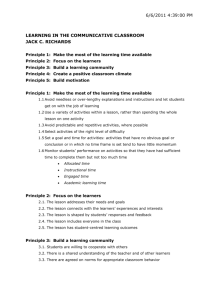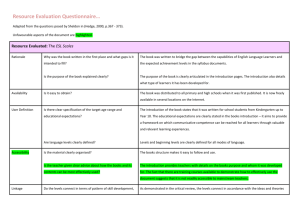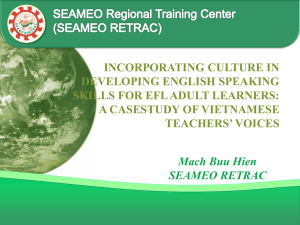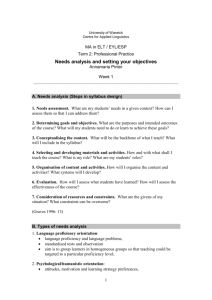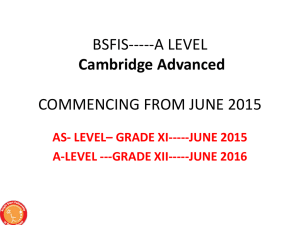LANGUAGE CURRICULUM DESIGN
advertisement
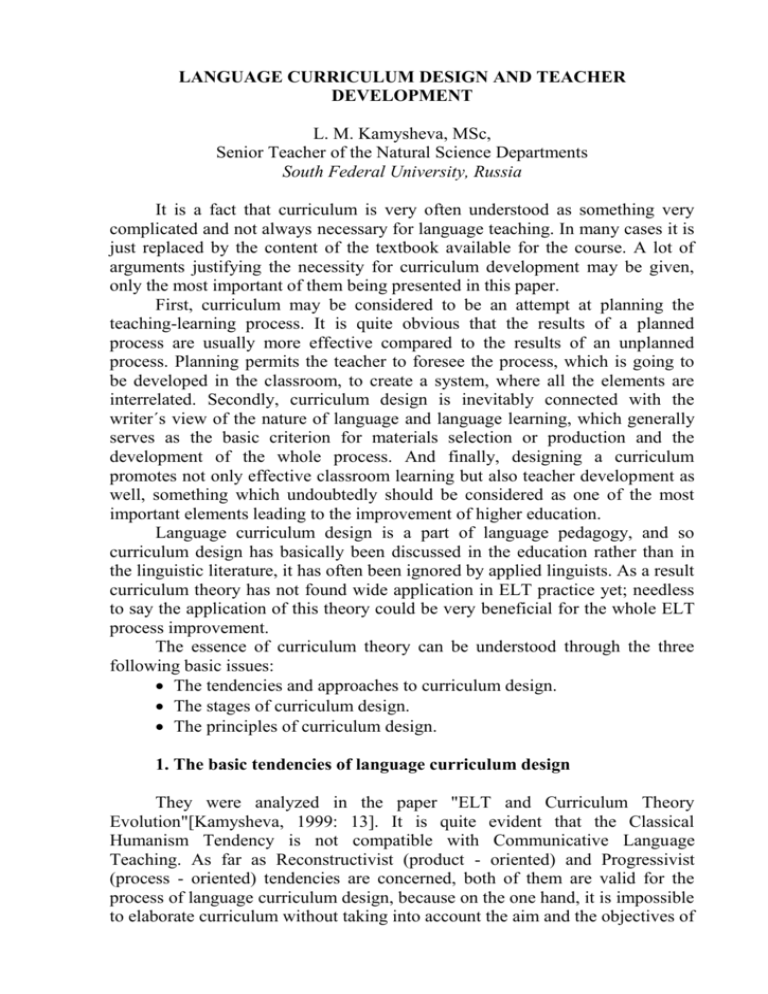
LANGUAGE CURRICULUM DESIGN AND TEACHER DEVELOPMENT L. M. Kamysheva, MSc, Senior Teacher of the Natural Science Departments South Federal University, Russia It is a fact that curriculum is very often understood as something very complicated and not always necessary for language teaching. In many cases it is just replaced by the content of the textbook available for the course. A lot of arguments justifying the necessity for curriculum development may be given, only the most important of them being presented in this paper. First, curriculum may be considered to be an attempt at planning the teaching-learning process. It is quite obvious that the results of a planned process are usually more effective compared to the results of an unplanned process. Planning permits the teacher to foresee the process, which is going to be developed in the classroom, to create a system, where all the elements are interrelated. Secondly, curriculum design is inevitably connected with the writer´s view of the nature of language and language learning, which generally serves as the basic criterion for materials selection or production and the development of the whole process. And finally, designing a curriculum promotes not only effective classroom learning but also teacher development as well, something which undoubtedly should be considered as one of the most important elements leading to the improvement of higher education. Language curriculum design is a part of language pedagogy, and so curriculum design has basically been discussed in the education rather than in the linguistic literature, it has often been ignored by applied linguists. As a result curriculum theory has not found wide application in ELT practice yet; needless to say the application of this theory could be very beneficial for the whole ELT process improvement. The essence of curriculum theory can be understood through the three following basic issues: The tendencies and approaches to curriculum design. The stages of curriculum design. The principles of curriculum design. 1. The basic tendencies of language curriculum design They were analyzed in the paper "ELT and Curriculum Theory Evolution"[Kamysheva, 1999: 13]. It is quite evident that the Classical Humanism Tendency is not compatible with Communicative Language Teaching. As far as Reconstructivist (product - oriented) and Progressivist (process - oriented) tendencies are concerned, both of them are valid for the process of language curriculum design, because on the one hand, it is impossible to elaborate curriculum without taking into account the aim and the objectives of learning; and on the other hand, stating objectives without working out the way of achieving them does not seem to be either rational or reasonable. So, the interdependence of product-oriented approach (skills-based curriculum) and process-oriented approach (task-based or procedural curriculum) is a vital principle of language curriculum design. 2. The stages of curriculum design According to Long & Richards [quoted in Johnson, 1989: IX] language curriculum design is regarded as a decision - making process and involves: Policy making. Needs assessment. Design and development. Teacher preparation and development. Programme management and evaluation. 2.1. Policy making Policy determination implies construction of political strategies with taking account of contextual constraints and in many cases may be expressed in terms of the aim of the programme. According to Nunan [1994] the aim of communicative language learning is achieving language proficiency based on the development of the four macro skills. It is quite natural that the level of language proficiency will be different for different contingents of learners and will depend on learners’ needs. For language faculties/departments preparing students for professional work with the English language (teachers, translators, interpreters) this level may be determined by taking into consideration the parameters given in " Cambridge Practice Test for First Certificate", which is a standard test for the first professional level. 2.2 Needs assessment On the basis of the identified aim it is possible to make an analysis of the learners’ needs both from the point of view of their linguistic needs (expressed in structures or functions) and their communicative needs expressed in communication situations. Needs assessment may also be made on the basis of the following approaches: Product-oriented analysis related to the findings about target proficiency. Process-oriented analysis related to the identification of needs of a learner in the learning situation including cognitive and affective variables such as learning attitude, learning style, motivation, personality, wants, etc. It is necessary to avoid an arbitrary, subjective approach to needs assessment. As Johnson writes: "Perception of needs can be expressed as a range from sensitive considerations of learners' statements about themselves to largely insensitive prescriptions about learners who may have had the bad luck to fall under the control of an education despot” [Johnson, 1989:55]. There is no doubt that a learner-centred curriculum should be based on the findings of the learners' needs analysis. 2.3 Curriculum design On the basis of the established aim and the findings of the needs analysis it is possible to identify the target proficiency objectives and from them the objectives for each year/term (or level). Programme objectives can also be classified as: Product objectives, which are real world objectives connected with the learners’ target language proficiency and performance. Process or pedagogic objectives, which are the experiences the learner will undergo in the classroom. Curriculum objectives having been identified, we can specify the learning content and the means necessary to gain the objectives. These means are usually the procedures, tasks or learning activities developed in the classroom with the aim of promoting the target proficiency. The content is usually understood as language items to be learned (grammar, vocabulary, pronunciation) organized within the framework of the topics. While planning the learning process we usually establish: Objectives or what is intended. Means or what is to be done to achieve the objectives planned. The results or what is achieved. The problem is that although the second stage turns out to be the most important, it is at the same time the least understood, and the main difficulty here consists in achieving a coherent, logical relation between the objectives and the process developed in the classroom. The coherent language curriculum is believed to be that one which is based on a logical and coherent relationship between the ends and the means. Evaluation usually deals with the learners' performance in terms of mastery or non-mastery of language programme objectives, when current performance is measured versus desired performance by means of testing, using both quantitative and qualitative criteria. There exist different approaches to evaluation; it can be product-oriented (summative evaluation) and/or process– oriented (formative evaluation) [Weir & Roberts, 1994]. It can be quantitative (based on quantitative criteria) and/or qualitative (based on qualitative criteria). All these types of evaluation are complementary and not mutually exclusive, their interdependence being of great importance to obtain valid findings. 2.4 Teacher preparation and development It is quite obvious that both curriculum development and implementation depend on teachers and that is why teacher preparation plays a very important role in the whole process of curriculum design, if it is regarded as a decisionmaking process. Teachers' action research is thought to be an invaluable tool in curriculum innovation and improvement. 2.5 Management and curriculum evaluation Program evaluation in many cases may result in curriculum research which is directly benefits curriculum development. Evaluation is defined by Brown as "the systematic collection and analysis of the relevant information necessary to promote the improvement of a curriculum and access effectiveness and efficiency." [Johnson, 1989: 223] According to Johnson, curriculum development would consist of a process of continuous adjustments or "fine tuning." Curriculum evaluation consists in the interaction of formative (process) and summative (product) evaluation. The stages of curriculum design having been considered, it is necessary to emphasize the dialectical character of the relationship existing among them. 3. The basic principles of language curriculum design 3.1. Coherence A curriculum is considered to be coherent when learners' achievements correspond to the curriculum aim and when there is logical relationship between the objectives stated and the process planned and developed in the classroom. An example of incoherent curriculum may be when communicative language teaching is designed within the framework of a language–centered curriculum. 3.2. Permanent change and innovation It is impossible to design a curriculum once forever; no curriculum can be perfect and it will always need some improvements, adjustments or "fine tuning" to meet the learners needs in the best possible way. But it is necessary to keep in mind that the change of one of the curriculum components will inevitably provoke change in the other components. 3.3. Different approaches integration The idea of product (skills-based) and process (procedures or task-based) approaches integration is of great importance for language programme design. This principle is connected with the principle of coherence too, because the logical relationship between the objectives identified and the process developed in the classroom is presented through the integration of skills-based and procedural curriculum. It is worth mentioning that curriculum design is directly connected with syllabus design, syllabus design being regarded as a contextually diminished view of curriculum design, implying that all the essential points of curriculum theory, its approaches, stages and principles, may be applied equally to syllabus design. Taking into account all the above aspects of curriculum theory it is possible to come to a conclusion that its application to our teaching practice would result in both further teacher development and in the improvement of the whole ELT process. References: 1. Carne P., Hashemi L. 1989. Cambridge Practice Test for First Certificate. Cambridge: CUP. 2. Johnson R. K. 1989. The Second Language Curriculum. Cambridge: Cambridge University Press. 3. Kamysheva L. ELT and Curriculum Theory Evolution. "English News" Journal. Spring 1999.BETA and the British Project for ELT Improvement in Bolivia. Sucre, Bolivia. 4. Markee N. 1997. Managing Curricular Innovation. Cambridge: CUP. 5. Nunan D. 1994. The Learner - Centered Curriculum. Cambridge: CUP. 6. Nunan D. 1996. Syllabus Design. Oxford: Oxford University Press. 7. Reid J. 1994. Change in the Language Classroom. Process and Intervention. ETF.32.1 8. Weir C., Roberts J. 1991. Evaluation in ELT. Oxford: OUP 9. White R. 1991. The ELT Curriculum. Oxford: OUP. 10. Addine F. 1997. Didáctica y Curriculum. Análisis de una experiencia. Universidad Pedagógica “Enrique Jose Varona”. Habana, Cuba. 11. Kamysheva L. Proyección Estratégica del Rediseño Curricular de la Mención Ingles (Carrera de Linguística e Idiomas de UATF). Tesis en opción de título de Master en Educación Superior. Curso Internacional de Maestría. Potosi, Bolivia.

